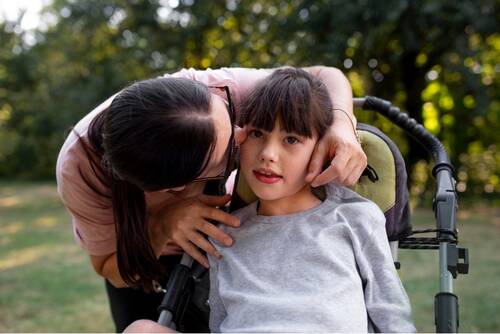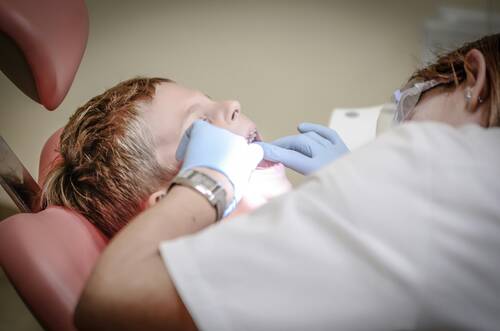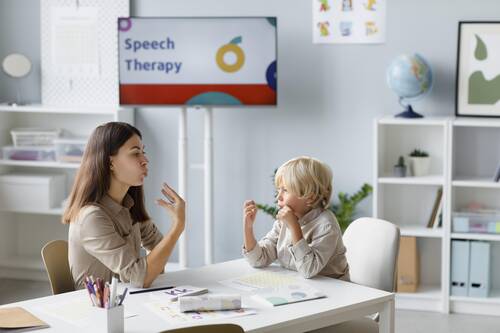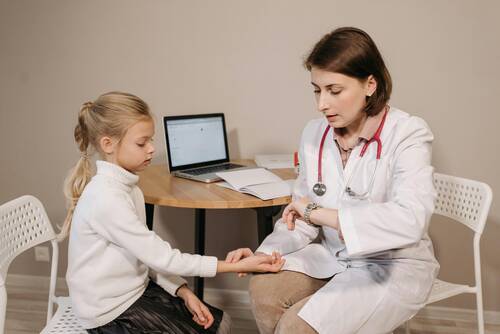While the process of childbirth is fascinating, it also has significant hazards. Birth injuries are more common than many believe, so it is advisable to be aware of the risks. Infant brain injury can cause severe disorders, including Cerebral Palsy. Here are some typical reasons for brain injury in newborns.
Author Interviews, Cannabis, Pediatrics / 26.03.2025
Study Finds Maternal Cannabis Use Associated with Behavior Disorders in Children
MedicalResearch.com Interview with:
Mr. Abay Tadesse, PhD candidate
School of Population Health
Curtin University
Australia
MedicalResearch.com: What is the background for this study?
Response: Few studies have investigated the association between maternal gestational cannabis use and the risk of disruptive behavioural disorders (DBDs) in offspring. Small sample sizes, reliance on self-reported data and focus on solely in-utero exposure often limit existing research, leading to inconsistent findings. Given the increasing prevalence of cannabis use during pregnancy, there is an urgent need for robust, population-based evidence to better understand its potential impact on child neurobehavioral outcomes.
This study aimed to examine the relationship between maternal cannabis use disorder (CUD) during pregnancy and postpartum periods and the risk of DBDs in offspring. Using linked health data from New South Wales, Australia, we conducted a population-based retrospective cohort study of live births between 2003 and 2005.
(more…)
Dental Research, Pediatrics / 26.03.2025
How to Choose a Family-Friendly Dental Clinic for Your Child’s Oral Health
Finding a kid-friendly dentist ensures a stress-free experience and builds lifelong dental habits. Learn how to pick the right clinic for your family.
A child’s early dental experiences shape their perception of oral care for life. Choosing a family-friendly dental clinic ensures a positive experience, reduces dental anxiety, and helps establish good oral hygiene habits from an early age.
For parents, finding the right clinic goes beyond just proximity—it’s about selecting a practice that understands the unique needs of children while offering preventive care, flexible scheduling, and a welcoming environment. Here’s how to find the best dental clinic for your family’s needs.
(more…)
Mental Health Research, Pediatrics, Technology / 17.03.2025
Exploring the Psychological Impact of Social Media on Teens
Adolescence is a time of some big transitions in terms of body and mental health. It is when teens develop cognitive, social, and emotional skills required for well-being in adulthood. However, it also presents challenges leading to anxiety and depression. The constant pressure on teenagers and the thought of not being able to cope with it can lead to depression.
One crucial factor that increases the risk of depression is the use of social media. Experts often ask: how common is teenage depression, and how does social media impact it? Some research indicates that social media use has proven to be a catalyst in the growth of mental health problems among teens.
In this article, we will look at how social media is influencing the psychology of teenagers, impacting their mental health.
(more…)
Author Interviews, Critical Care - Intensive Care - ICUs, Genetic Research, Pediatrics / 10.03.2025
Optimized Care Improves Survival of Infants with Severe Genetic Bone Disorder, Osteogenesis imperfecta
MedicalResearch.com Interview with:
Ricki S. Carroll, MD
Complex Care and Palliative Care Physician, Skeletal Dysplasia and Palliative Care Teams
Nemours Children’s Hospital
Wilmington, Delaware
MedicalResearch.com: What is the background for this study?
Response: Individuals with Osteogenesis imperfecta (OI) are often classified into one of four subtypes: type I (mild/nondeforming), type II (perinatal lethal), type III (severe/progressively deforming) and type IV (moderately deforming); however, this classification system continues to evolve with increasing knowledge (Sillence, 1979; Van Dyke & Sillence, 2014). Those with a mild phenotype are often diagnosed postnatally or in the pediatric setting after experiencing multiple unexplained fractures. Concerns for moderate to severely presenting OI are often noted in utero when fractures, shortening, and/or bowing of the long bones are found on prenatal ultrasound (Marini et al, 2017).
When Osteogenesis imperfecta is suspected and/or molecularly confirmed in the prenatal period, families may be counseled that the diagnosis is lethal or severely life-limiting based on prenatal ultrasound observations and previously reported genotype-phenotype correlations (Yoshimura et al., 1996; Krakow et al., 2009). Ultrasound parameters for predicting lethality in skeletal dysplasias have been studied and include the chest-to-abdominal circumference ratio of <0.6 and femur length-to-abdominal circumference ratio of <0.16 (Yoshimura et al., 1996; Rahemtullah et al., 1997; Ramus et al., 1998). However, there are nuances to this strategy, for instance in cases where bowing deformities and fractures limit the accuracy of true femur length measurements (Milks et al., 2017). While genotype-phenotype correlations are also considered when predicting lethality, there can be a range of clinical variability even among those with the same genotype (Rauch et al., 2004, Marini et al, 2017). Some specialized delivery centers have reported on the accuracy of these methods in predicting lethality, yet many of the pregnancies evaluated are ultimately terminated, further limiting the ability to draw conclusions (Yeh et al., 2011). These limitations pose a challenge for perinatal providers counseling families on the diagnosis and attempting to prognosticate postnatal survival probability. Consequently, this information can cloud conversations surrounding delivery planning and influence access to potential life-saving therapies including invasive mechanical ventilation and feeding support.
Advancements in medical technology and the option for life-sustaining interventions have significantly altered the prognoses for severely affected infants. In this manuscript, we describe perinatal outcomes of infants referred to a single specialized center after receiving a prior diagnosis of possibly lethal, lethal or type II OI where parents sought medical intervention after birth. We also outline advances in respiratory and feeding support needs, as well as length-of-stay for these neonates. The success of this multidisciplinary approach to neonatal OI care both challenges previously defined expectations for this patient population and offers a chance at survival.
(more…)
Legal-Malpractice, OBGYNE, Pediatrics / 17.02.2025
Cerebral Palsy: Understanding the Complexities Involved in Treatment and Diagnosis
Cerebral palsy (CP) is a group of permanent movement disorders that directly impact muscle tone and posture. The primary cause of these disorders is brain damage before, during, or shortly after birth. While the condition itself presents a complex set of challenges, understanding the intricacies involved in diagnosis and treatment can help make things better for individuals with CP and their families.
A Major Issue Related to the Treatment of Cerebral Palsy
While you must educate yourself about diagnosis and treatment options, you must acknowledge a troubling aspect surrounding CP first: the potential for medical negligence. A large number of cerebral palsy cases are unfortunately linked to errors and omissions in medical care during labor, pregnancy, or delivery. These errors may include delayed or inappropriate C-sections, failure to monitor fetal distress, negligence in managing neonatal complications, and misuse of vacuum extractors or forceps. (more…)
Author Interviews, Autism, Pediatrics / 14.02.2025
NYU Study Finds No Link Between Maternal Illness and Autism
MedicalResearch.com Interview with:
Magdalena Janecka PhD
Associate Professor, Department of Child and Adolescent Psychiatry
Associate Professor, Department of Population Health
NYU Grossman School of Medicine
MedicalResearch.com: What is the background for this study?
Response: Several earlier studies have indicated that certain maternal conditions in pregnancy – for example, depression or obesity - are associated with higher rates of autism in offspring. However, the majority of the conditions females experience during pregnancy have not been investigated in the context of autism before. Additionally, while the evidence that these associations are likely not causal existed for a few maternal diagnoses, it was not clear whether this applies to just a few associations that have been examined or is more widespread.
Our study investigated the association between all maternal conditions in pregnancy (provided they were common enough to allow us to estimate their effects) and the likelihood of autism in the child. Then, for the significant associations, we tested whether these associations seemed causal, or whether they were instead attributable to other confounding factors. Confounders are other variables that can influence the relationship between the variables in a study, for example maternal health and autism. Factors shared by family members, i.e. familial factors (e.g., genetics) are common confounders in studies like ours, and are particularly difficult to account for.
(more…)
Allergies, Author Interviews, NEJM, Pediatrics / 11.02.2025
Mount Sinai Study Emphasizes Importance of Personalizing Peanut Allergy Immunotherapy in Children
Editor's note: Do not attempt immunotherapy for peanut or other allergens without the express direction of your health care provider. Life-threatening reactions may occur.
MedicalResearch.com Interview with:
Scott H. Sicherer, MD
Elliot and Roslyn Jaffe Professor of Pediatrics, Allergy and Immunology
Director, Jaffe Food Allergy Institute
Division Chief, Pediatric Allergy
Medical Director, Clinical Research Unit
Icahn School of Medicine at Mount Sinai
Jack and Lucy Clark Department of Pediatrics
Mount Sinai Kravis Children’s Hospital
New York, NY 10029
MedicalResearch.com: What is the background for this study?
Response: About 2% of people have a peanut allergy. While many of them are exquisitely allergic to tiny amounts, about half can tolerate a half a peanut kernel or more before they have symptoms, although the symptoms can be severe.
Current studies and FDA approved treatments for peanut allergy have typically focused on people reacting to about half a peanut or less. We thought that those with higher threshold may be more easily treated.
We focused on children ages 4-14 years who we identified through a medically supervised feeding test as having allergic reactions from 443 to 5043 mg of peanut protein. A peanut kernel is about 250 mg of peanut protein. The 73 children were randomized to a treatment (oral immunotherapy, OIT) using home-measured, store bought peanut butter versus continuing the standard of care, avoidance. OIT involves medically supervised dosing going from a small amount to gradually increasing larger amounts. The increases are done under direct allergist supervision, then the tolerated dose is taken at home daily. Families are given instructions about avoiding things that can cause a reaction from dosing, such as exercise after a dose, and to skip dosing for illness. Dosing can cause reactions and they were instructed on how to recognize and treat any such reactions. We did increases every 2 months.
Most of the children (62) stayed in the study to be tested after the period of treatment, that aimed for having a level tablespoon of peanut butter each day. All of the treated children who completed testing (32) were able to eat 9 grams of peanut. Only 3 of 30 who continued to avoid peanut were able to do this.
(more…)
Author Interviews, Cannabis, JAMA, Pediatrics, UCSD / 30.01.2025
UCSD Study Finds Secondhand Cannabis Smoke A Significant Risk for Children
MedicalResearch.com Interview with:
John Bellettiere, PhD
Assistant Adjunct Professor
Herbert Wertheim School of Public Health & Human Longevity Science
University of California, San Diego
MedicalResearch.com: What is the background for this study?
Response: Smoking is the most common method of cannabis use and generates harmful emissions. Cannabis is often smoked indoors, which exposes non-smokers, including children, to these emissions. Our research analyzed in-home cannabis smoking practices to determine if there is an association between this behavior and the detection of cannabis biomarkers in children.
(more…)
Author Interviews, Disability Research, Pediatrics / 08.01.2025
How Pediatric Care Shapes The Future Of Disability Support
Author Bio:
Lorraine Culpo is a dedicated writer with a focus on healthcare, disability advocacy, and family well-being. With a passion for shedding light on the importance of early pediatric support, she aims to empower readers with insights into how comprehensive care can shape brighter futures for children with disabilities.
 Pediatric care plays an essential role in helping children grow and develop, especially those living with disabilities. Through early support, medical care, and learning resources, pediatric care improves children’s outcomes and builds a foundation for a more inclusive society. Understanding how pediatric care shapes disability support can help families, educators, and healthcare providers create an environment where every child can thrive.
Pediatric care plays an essential role in helping children grow and develop, especially those living with disabilities. Through early support, medical care, and learning resources, pediatric care improves children’s outcomes and builds a foundation for a more inclusive society. Understanding how pediatric care shapes disability support can help families, educators, and healthcare providers create an environment where every child can thrive.
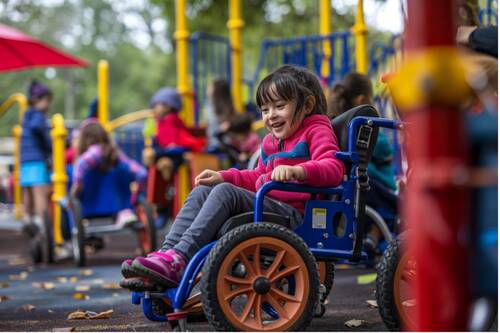 Pediatric care plays an essential role in helping children grow and develop, especially those living with disabilities. Through early support, medical care, and learning resources, pediatric care improves children’s outcomes and builds a foundation for a more inclusive society. Understanding how pediatric care shapes disability support can help families, educators, and healthcare providers create an environment where every child can thrive.
Pediatric care plays an essential role in helping children grow and develop, especially those living with disabilities. Through early support, medical care, and learning resources, pediatric care improves children’s outcomes and builds a foundation for a more inclusive society. Understanding how pediatric care shapes disability support can help families, educators, and healthcare providers create an environment where every child can thrive.
Early Support Changes Lives
Early support services can make a big difference for children with disabilities. When doctors and specialists spot developmental challenges early, children can get help sooner. This early start allows them to build important skills at key stages of growth. For example, speech therapy can help a child with delayed language skills improve their ability to communicate. Physical therapy can help children with motor challenges gain strength and coordination. These interventions work best when they begin as early as possible, which increases the chances that children will meet milestones that lead to more independence. In many cases, NDIS treatment plans for children ensure that the support they receive is tailored to their specific developmental and medical requirements. It provides a structured approach that aligns with their long-term goals. (more…)
Mental Health Research, Pediatrics, Therapy / 21.11.2024
Proven Approaches to Overcoming Behavioral Challenges in Adolescents
Adolescence, a period of rapid physical and emotional change, often comes with its share of behavioral challenges. As young people navigate the complexities of this transitional phase, they may struggle with anger management, impulsivity, and other disruptive behaviors. Fortunately, a variety of proven approaches can help adolescents overcome these challenges.
This article explores some of the most effective strategies for addressing behavioral issues in adolescents.
I. Anger Management Courses
Anger management is a common challenge among adolescents. Young people may also find themselves in legal trouble as a result of losing control in difficult situations. Anger management courses online provide flexible and accessible options for young people to learn how to control their emotions effectively. (more…)Why Pediatric Dentists Are Important for Kids?
Pediatric dentists aren’t just regular dentists—they’re specialists trained specifically to care for children’s dental health from infancy through the teenage years. This specialized training means that they understand more about baby teeth, growing jaws, and the best ways to help kids feel comfortable during a dental visit. Pediatric dentists often complete additional training after dental school to become experts in managing children’s unique dental needs, behaviors, and even anxieties. Their offices are designed to make kids feel safe, comfortable, and at ease. From playful decorations and kid-sized chairs to dentists who know how to talk to children about their oral health, pediatric dental clinics are usually kid-friendly spaces. These environments can make a big difference, especially for kids who feel nervous or scared about visiting the dentist. But the care that pediatric dentists provide goes beyond just helping kids feel relaxed. Pediatric dentists are skilled at managing dental issues unique to children, such as dealing with baby teeth, guiding the eruption of adult teeth, and addressing early signs of cavities, gum disease, and other issues. They also understand the importance of early intervention in preventing long-term dental problems. (more…)
Technology has been benefitting the field of speech therapy for ages, but living in the digital age; we have not seen such a jump in innovations that have been helping speech-language pathologists (SLPs), otherwise known as speech therapists, better diagnose and treat patients as we have in the past few years, both in and out of therapy.
In this article, we’ll discuss the cutting-edge technology, from tools to apps, that has been implemented to improve the role of speech therapy.
What are the limitations and challenges faced by speech pathologists?
As with all professions, speech therapists also share a number of limitations and challenges when it providing effective treatment for individuals. While they do make a huge difference in the lives of their patients, here are some of the biggest hurdles that SLPs face in their field:- Sessions and treatment are time-consuming - speech therapy requires multiple in-person sessions on a weekly basis in order to see results. It’s because of this that many people don’t attend sessions as they don’t have the time or resources to make it to regular sessions.
- It can be difficult to keep individuals engaged - many of the methods used in traditional speech therapy can seem tedious and less engaging. This makes it difficult to motivate individuals to perform, especially when working with young children.
- Limited accessibility - another huge limitation of speech therapy is that it’s not readily available in underserved and rural areas, which means there are a lot of people not receiving treatment purely because there isn’t a speech therapist close by.
Cannabis, OBGYNE, Pediatrics / 30.10.2024
JAMA Peds Study Finds Prenatal Exposure to Cannabis Linked to Aggressive Behavior and Decreased Executive Function in Children
MedicalResearch.com Interview with:
Sarah Keim, PhD
Associate Professor, Epidemiology
College of Public Health
The Ohio State University
MedicalResearch.com: What is the background for this study?
Response: Marijuana is the illicit substance most commonly used during pregnancy, and use is increasing. Some evidence suggests that marijuana is associated with deficits in executive function and increased delinquent behavior in school-age children and adolescents, with potential downstream impacts on achievement and social functioning.
However, this evidence comes largely from only 2 studies several decades old. Today cannabis is more than 10 times more potent than it was several decades ago.
(more…)
Gastrointestinal Disease, Legal-Malpractice, Pediatrics / 25.10.2024
A Look Into Why Some Baby Formula Companies Have Lawsuits Against Them
As parents, we always want the best for our children. This is especially true when it comes to their nutrition and overall health. That's why choosing the right baby formula is crucial in ensuring that our little ones receive the necessary nutrients for healthy growth and development.
Unfortunately, not all baby formulas on the market are safe and effective. In fact, there have been cases where certain brands of baby formula have caused serious health issues in infants, leading to lawsuits against the manufacturers. NEC baby formula lawsuit lawyers help parents hold the responsible parties accountable for their actions and secure compensation.
(more…)
Legal-Malpractice, OBGYNE, Pediatrics / 19.10.2024
The Different Forms of Medical Negligence That Cause Cerebral Palsy
Cerebral Palsy is a neurological disorder that affects movement, posture, and coordination. It is caused by damage to the brain during or shortly after birth and can lead to lifelong disabilities. While there are many known causes of cerebral palsy, medical negligence during childbirth is one of them.
When a child is born with cerebral palsy due to medical negligence, it can have devastating effects on both the child and their family. In such cases, seeking help from lawyers for a child's birth injury may be necessary in order to receive justice and compensation for the harm caused.
Medical negligence refers to any act or failure to act by a healthcare professional that falls below the accepted standard of care, resulting in harm to the patient. In the case of cerebral palsy, several forms of medical negligence can occur during childbirth and lead to this condition. This is what is discussed in this article.
(more…)
OBGYNE, Pediatrics / 19.10.2024
How a Birth Injury Can Affect Parents’ Lives
When a new baby is brought into the world, many parents have one of the happiest moments of their lives. However, for some parents, it is not a happy moment, as some babies are born with injuries that could alter their lives completely.
Birth injuries are any physical wounds sustained during labor or delivery. These injuries can range in severity from minor cuts and bruises to more severe conditions, including brain damage or cerebral palsy.
Birth injury is terrible enough for a child, but parents' lives are also affected, and this is something that should not be disregarded. Caring for a child with a birth injury entails enormous emotional, financial, and practical demands that can negatively impact parents' mental, physical, and financial health. You might need the help of lawyers experienced in birth injuries to fight for your rights.
Author Interviews, COVID -19 Coronavirus, JAMA, OBGYNE, Pediatrics / 16.10.2024
UCSF Study Examines Childhood Development after Maternal Covid Infection
MedicalResearch.com Interview with:
Eleni G. Jaswa, MD, MSc
Assistant Professor, Ob/Gyn, Reproductive Science
UCSF
MedicalResearch.com: What is the background for this study?
Response: Some infections during pregnancy have been associated with abnormal neurodevelopment in children. This is likely due to the infection itself, or the maternal immune system response to infection. We sought to determine whether maternal COVID-19 infection during pregnancy, a now common occurrence, was associated with changes in children's neurodevelopment out to 24-months-old, compared to control children not exposed to maternal COVID-19 in utero.
(more…)
A parent’s selection of their paediatrician is a crucial decision that can significantly influence their child's health and well-being. From overseeing newborn check-ups to managing developmental milestones, paediatricians are key partners for families in ensuring that children receive timely treatment for ailments and the right preventive care to keep them healthy. The best paediatricians also build long-term relationships, helping families navigate the journey from infancy through adolescence together.
In Singapore, the paediatric healthcare system is both well-established and comprehensive. Parents have access to highly specialised care at leading institutions, and programmes like PaedsENGAGE further enhance paediatric care by expanding it into community settings. This gives parents plenty of options for finding the right paediatric clinic in Singapore, but the abundance of choice can also make the decision feel like an overwhelming one sometimes. A parent should know what to look for—and what their ideal standard of care is like for their child in the hands of a competent paediatrician.
The following sections highlight essential qualities to consider when selecting a paediatrician—“green flags” that indicate you’ve found someone who will be a true partner in your child’s health.
Author Interviews, Genetic Research, Nutrition, Pediatrics / 25.09.2024
UCL Study Finds Tendency to Fussy Eating May Be Genetic
MedicalResearch.com Interview with:
Dr Zeynep Nas Ph.D.
Postdoctoral Research Fellow
Department of Behavioural Science and Health
Institute of Epidemiology & Health Care
University College London
MedicalResearch.com: What is the background for this study?
Response: We were interested in why some children are more selective in their food intake and more reluctant to try new foods compared to those who are not. We investigated this question in a twin study, which compares identical twins (who share all of their genes) to non-identical twins (who share half) to understand the relative influence of genetics versus the environment in shaping individual differences in fussy eating.
(more…)
Gaming, Pediatrics, Technology / 23.09.2024
The Influences Shaping Today’s Youth
Today’s youth are growing up in a world that is constantly evolving, shaped by rapid technological advances, shifting social norms, and global connectivity. The influences affecting their lives are more diverse and accessible than ever before, making it both an exciting and complex time to navigate adolescence. Understanding these influences is crucial in shaping the future, as today’s youth are the leaders, thinkers, and innovators of tomorrow.
This article explores the key influences shaping today’s youth, from technology and social media to global movements and shifting cultural landscapes.
- Technology and Digital Connectivity
Author Interviews, Dental Research, Pediatrics / 10.09.2024
What to Know about Invisalign for Kids in South Surrey? How Is It Different from Adults?
Are you considering Invisalign for your child in South Surrey but wondering how it differs from the treatment adults receive? This particular procedure has become a popular choice for orthodontic care, offering a discreet and convenient way to straighten teeth. However, the approach for children can differ significantly from that for adults. This article will explain what you need to know about Invisalign for kids and how it stands apart from adult dental treatments in South Surrey.
Understanding Invisalign for Kids
Invisalign South Surrey for Kids is specifically designed to cater to the unique dental needs of growing children. The treatment focuses on aligning teeth and guiding the proper jaw and teeth development. This early intervention is crucial in preventing more severe orthodontic issues later in life. While the clear aligners work similarly to those for adults, the process and considerations are different. (more…)
Author Interviews, Cognitive Issues, Environmental Risks, NIH, Pediatrics / 27.08.2024
NIEHS Examines Link Between Flouride in Water and IQ in Children
MedicalResearch.com Interview with:
Rick Woychik, Ph.D.
Director of the National Toxicology Program
Director of the National Institute of Environmental Health Sciences
Principal Investigator
Mammalian Genome Research Group
Division for Intramural Research at NIEHS
MedicalResearch.com: What is the background for this study?
Response: Since 1945, the use of fluoride has been a successful public health initiative for reducing dental cavities and improving general oral health of adults and children. There is a concern, however, that some pregnant women and children may be getting more fluoride than they need because they now get fluoride from many sources including treated public water, water-added foods and beverages, teas, toothpaste, floss, and mouthwash, and the combined total intake of fluoride may exceed safe amounts.
Therefore, the National Toxicology Program (NTP) conducted a systematic review of the published scientific literature on the association between fluoride exposure and neurodevelopment and cognition. The NTP released their findings in a State of the Science Monograph on August 21, 2024, and posted to the NTP website. A corresponding meta-analysis on children’s IQ has been accepted by a scientific journal for publication later in 2024.
The NTP started this work in 2016. As with all research documents intended for publication, the NTP fluoride monograph and meta-analysis underwent rigorous scientific evaluation. The evaluation process has involved many steps. The draft fluoride monograph received significant critical feedback during peer-review by the National Academies of Science, Engineering and Medicine (NASEM), from other external experts, and from experts in several federal health agencies. After modifications were made, additional evaluation following a rigorous scientific framework was conducted by subject matter experts organized by the NTP Board of Scientific Counselors. I am very pleased that this document is now complete and available for reference.
Since fluoride is such an important topic to the public and to public health officials, it was imperative that we made every effort to get the science right. I commend the report authors, the NTP Board of Scientific Counselors, and countless subject matter experts who participated in this evaluation. The monograph represents a thorough review of the data, and the various interpretations of the data, to accurately reflect what we know and where additional research is needed.
(more…)
Author Interviews, Diabetes, Pediatrics / 23.07.2024
Risk for Type 1 Diabetes Higher for Boys than Girls in Later Childhood
MedicalResearch.com Interview with:
Prof. Richard Oram PhD
Associate Professor, Diabetes UK Harry Keen Fellow
Institute of Biomedical and Clinical Science and
NIHR Exeter Clinical Research Facility
University of Exeter
MedicalResearch.com: What is the background for this study?
Response: In contrast to most autoimmune diseases, male sex is a risk factor for type 1 diabetes (T1D). This raises the hypothesis that either immune, metabolic, or other differences between sexes may impact risk or progression through stages of T1D. However, understanding the mechanisms for this could inform future interventions or risk stratification of individuals at-risk of T1D.
(more…)
Eating Disorders, Mental Health Research, Pediatrics / 01.07.2024
Pediatric Eating Disorders Increasing: More Therapeutic Intervention Needed
In an ideal world, therapeutic intervention for pediatric eating disorders would start as early as possible with a regular regimen...
Education, Pediatrics, Psychological Science / 29.06.2024
Fundamentals of Applied Behavior Analysis (ABA) Therapy
 Sensory processing disorders (SPD) present a complex challenge for many children and their families, affecting the way kids interact with their environment and respond to sensory stimuli. Applied behavior analysis (ABA) therapy has emerged as a promising approach to support those with SPD. By understanding and addressing the individual needs that come with sensory integration issues, ABA therapy can enhance a child's ability to navigate the world around them with greater confidence and competency. Below, we delve into the ways that ABA therapy can be tailored for children with sensory processing challenges.
ABA therapy is a research-based intervention widely recognized for its effectiveness in helping children with autism and related disorders. It involves structured techniques to improve social interactions, communication, and learning through positive reinforcement. The therapy targets the development of specific skills, behaviors, and responses to various stimuli.
At the heart of ABA therapy lies the consistent measurement and analysis of behavior and the adaptation of strategies to encourage desired behaviors. In practice, this might include breaking down tasks into small, manageable steps and rewarding accomplishments, hence reinforcing the desired behavior.
For those interested in pursuing a deeper understanding or career in this field, a masters applied behavior analysis can equip professionals with advanced skills and knowledge. Comprehensive programs prepare graduates to apply ABA principles effectively in diverse situations, including SPD interventions.
(more…)
Sensory processing disorders (SPD) present a complex challenge for many children and their families, affecting the way kids interact with their environment and respond to sensory stimuli. Applied behavior analysis (ABA) therapy has emerged as a promising approach to support those with SPD. By understanding and addressing the individual needs that come with sensory integration issues, ABA therapy can enhance a child's ability to navigate the world around them with greater confidence and competency. Below, we delve into the ways that ABA therapy can be tailored for children with sensory processing challenges.
ABA therapy is a research-based intervention widely recognized for its effectiveness in helping children with autism and related disorders. It involves structured techniques to improve social interactions, communication, and learning through positive reinforcement. The therapy targets the development of specific skills, behaviors, and responses to various stimuli.
At the heart of ABA therapy lies the consistent measurement and analysis of behavior and the adaptation of strategies to encourage desired behaviors. In practice, this might include breaking down tasks into small, manageable steps and rewarding accomplishments, hence reinforcing the desired behavior.
For those interested in pursuing a deeper understanding or career in this field, a masters applied behavior analysis can equip professionals with advanced skills and knowledge. Comprehensive programs prepare graduates to apply ABA principles effectively in diverse situations, including SPD interventions.
(more…)
Every parent wants the best for their children and envisions a future where they thrive in all aspects of life. To make this dream come true, you need to look after their physical well-being, particularly their growth and development.
While genetics play a significant role in growth, providing the right environment and resources is equally important. This includes a balanced diet, regular exercise, ample sleep, and addressing any deficiencies. Let’s dive into a few of the most important ways to help your kids grow big and strong.
Nutrition for Growth
Making sure your child receives the right balance of nutrients is essential for them to reach their full physical potential. First, focus on providing a variety of nutrient-dense foods. This includes fruits, vegetables, whole grains, lean proteins, and healthy fats. These foods supply essential vitamins, minerals, and other nutrients crucial for growth, such as calcium for bone development and protein for muscle growth. It's also important to pay attention to the balance of macronutrients in your child's diet. Carbohydrates, proteins, and fats all play distinct roles in supporting growth and overall health. Carbohydrates give them energy for daily activities, proteins are necessary for tissue repair and muscle development, and healthy fats are vital for brain development and hormone regulation. Aim for a balanced intake of these macronutrients to ensure your child has the fuel they need to thrive. Finally, establishing regular meal and snack times can help support consistent energy levels throughout the day. Offering a combination of food groups at each meal and snack can help keep hunger at bay and provide a steady supply of nutrients to support growth. Supplementing their diet with products from TruHeight may help promote optimal growth and fill in any nutritional gaps. Please be sure to consult with your child's health care provider before starting any supplements, vitamins or specific diet plan. (more…)
Author Interviews, Pediatrics, USPSTF, Weight Research / 25.06.2024
USPSTF: Intervention Recommendations for Children and Teens with High Body Mass Index
MedicalResearch.com Interview with:
John M. Ruiz, Ph.D
Associate Professor of Clinical Psychology
Department of Psychology
University of Arizona
Dr. Ruiz is the incoming editor-in-chief of the American Psychological Association (APA) journal, Health Psychology
Dr. Ruiz joined the U.S. Preventive Services Task Force in January 2022
MedicalResearch.com: What is the background for this study? What are the main findings?
Response: Almost 20 percent of children and teens in the United States have a high body mass index (BMI), the standard measure of obesity. However, there are proven ways that clinicians can help kids and teens manage their weight and stay healthy. We found that intensive behavioral interventions can help children age 6 and older who have a high BMI both achieve a healthy weight and improve their quality of life.
(more…)
 Navigating the world of sensory play can be both fun and educational for parents and children. Engaging children in simple tactile exercises not only supports their sensory experiences but also aids in their overall development. From the squishy delight of homemade slime to the soothing textures of sand art, these activities offer meaningful ways to develop the tactile system.
Incorporating activities like these into your daily routine can be especially beneficial for children requiring additional sensory input. Occupational therapy fine motor activities, such as kneading playdough or molding clay, can significantly improve their fine motor skills while providing a therapeutic, sensory-rich experience. It's important to note that such activities are not only entertaining but also essential for strengthening fine motor control and sensory integration.
By exploring various tactile exercises, parents can provide their children with valuable sensory experiences that foster growth and learning. Activities like filling a sandbox or creating DIY slime can be both enjoyable and foundational for their cognitive and physical development. These tactile activities can serve as excellent tools in a child's growth journey, combining playfulness with educational value. Please keep in mind that this is only an informative article and not medical advice; if you need further help, contact a medical expert.
Navigating the world of sensory play can be both fun and educational for parents and children. Engaging children in simple tactile exercises not only supports their sensory experiences but also aids in their overall development. From the squishy delight of homemade slime to the soothing textures of sand art, these activities offer meaningful ways to develop the tactile system.
Incorporating activities like these into your daily routine can be especially beneficial for children requiring additional sensory input. Occupational therapy fine motor activities, such as kneading playdough or molding clay, can significantly improve their fine motor skills while providing a therapeutic, sensory-rich experience. It's important to note that such activities are not only entertaining but also essential for strengthening fine motor control and sensory integration.
By exploring various tactile exercises, parents can provide their children with valuable sensory experiences that foster growth and learning. Activities like filling a sandbox or creating DIY slime can be both enjoyable and foundational for their cognitive and physical development. These tactile activities can serve as excellent tools in a child's growth journey, combining playfulness with educational value. Please keep in mind that this is only an informative article and not medical advice; if you need further help, contact a medical expert.
Key Takeaways
- Tactile exercises enhance sensory experience and overall development.
- Occupational therapy fine motor activities improve fine motor skills and sensory integration.
- Simple activities like sand art and DIY slime offer fun, beneficial playtime.
Author Interviews, Autism, Nature, Pediatrics / 11.04.2024
BU Study Finds Existence of Three Separate Language Comprehension Mechanisms
MedicalResearch.com Interview with:
Dr. Andrey Vyshedskiy, PhD
Founder and CEO of ImagiRation LLC
Neuroscientist, Boston University
MedicalResearch.com: What is the background for this study?
Response: The common intuitive belief is that language comprehension development follows a linear trajectory: children acquire one grammatical rule at a time.
Over 20 years ago, Dr. A. Vyshedskiy, predicted that instead of linear development, language should unfold in three steps corresponding to three language comprehension mechanisms of increasing complexity. The study of 31845 autistic individuals, published today in the journal npj Mental Health Research, validates this prediction. The implications of this discovery are reaching far and wide.
The traditional definition of language is highly ambiguous. For some philosophers, “language” is equivalent to a “communication system.” Others argue that “language” must be defined more narrowly, in a way that is unique to humans. The results of the new study streamline terminology for describing different language comprehension mechanisms. The ensuing discussion of which language comprehension mechanisms are unique to humans and which are shared with other apes is expected to be most interesting.
(more…)






